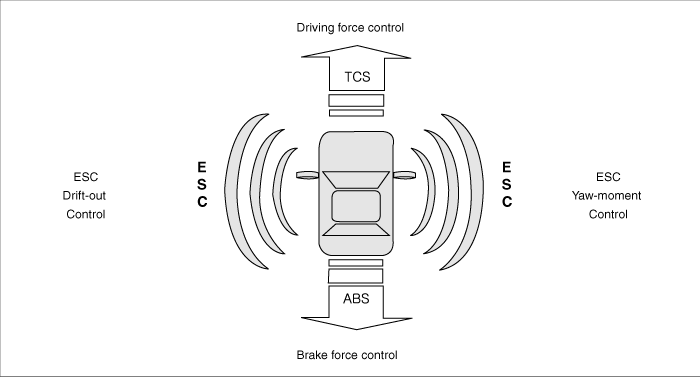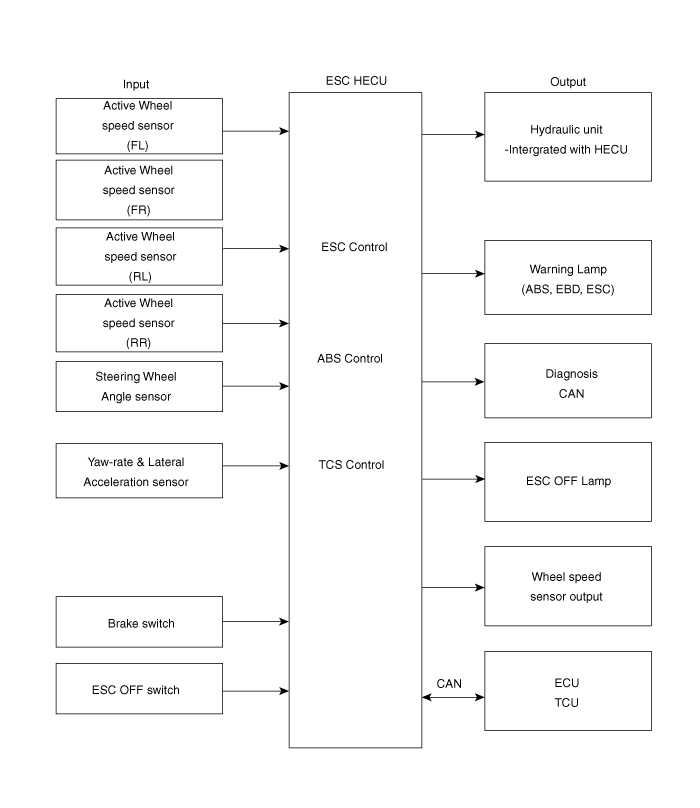 Kia Rio: Description of ESC
Kia Rio: Description of ESC
Electronic Stability Control (ESC) recognizes critical driving conditions,
such as panic reactions in dangerous situations, and stabilizes the vehicle
by wheel-individual braking and engine control intervention.
ESC adds a further function known as Active Yaw Control (AYC) to the ABS,
TCS, EBD and ESC functions. Whereas the ABS/TCS function controls wheel slip
during braking and acceleration and, thus, mainly intervenes in the longitudinal
dynamics of the vehicle, active yaw control stabilizes the vehicle about its
vertical axis.
This is achieved by wheel individual brake intervention and adaptation
of the momentary engine torque with no need for any action to be taken by the
driver.
ESC essentially consists of three assemblies : the sensors, the electronic
control unit and the actuators.
The stability control feature works under all driving and operating conditions.
Under certain driving conditions, the ABS/TCS function can be activated simultaneously
with the ESC function in response to a command by the driver.
In the event of a failure of the stability control function, the basic
safety function, ABS, is still maintained.

Description of ESC Control
ESC system includes ABS/EBD, TCS and AYC function.
ABS/EBD function : The ECU changes the active sensor signal (current shift)
coming from the four wheel sensors to the square wave. By using the input of
above signals, the ECU calculates the vehicle speed and the acceleration & deceleration
of the four wheels. And, the ECU judges whether the ABS/EBD should be actuated
or not.
TCS function prevents the wheel slip of drive direction by adding the
brake pressure and engine torque reduction via CAN communication. TCS function
uses the wheel speed sensor signal to determine the wheel slip as far as ABS
function.
AYC function prevents unstable maneuver of the vehicle. To determine the
vehicle maneuver, AYC function uses the maneuver sensor signals(Yaw Rate Sensor,
Lateral Acceleration Sensor, Steering Wheel Angle Sensor).
If vehicle maneuver is unstable (Over Steer or Under Steer), AYC function
applies the brake pressure on certain wheel, and send engine torque reduction
signal by CAN.
After the key-on, the ECU continually diagnoses the system failure. (self-diagnosis)If
the system failure is detected, the ECU informs driver of the system failure
through the BRAKE/ABS/ESC warning lamp. (fail-safe warning)

Input and Output Diagram

1. HECU module
2. Front wheel speed sensor
3. Rear wheel speed sensor
4. Yaw rate & G sensor
5. Steering angle sensor
6. ABS Warning lamp
7. Parking brake/EBD warn ...
ESC Hydraulic System Diagram
1.
ESC Non-operation : Normal braking.
Solenoid valve
Continuity
Valve
Motor ...
See also:
Front Impact Sensor (FIS) Description
The front impact sensor (FIS) is installed in the front side member. They
are remote sensors that detect acceleration due to a collision at its mounting
location. The primary purpose of the F ...
Operation
Passive Functions
The system allows the user to access the vehicle without having to perform
any actions (e.g. RKE button pressing) with the SMART KEY fob. It is sufficient
that a valid S ...
Component Location
1. Tailgate actuator & switch
2. Rear door switch
3. Body control module
4. Key warning switch
5. Front door switch
6. Front door lock actuator & switch
7. Rear do ...
 Kia Rio: Description of ESC
Kia Rio: Description of ESC


 Components
Components ESC Operation Mode
ESC Operation Mode